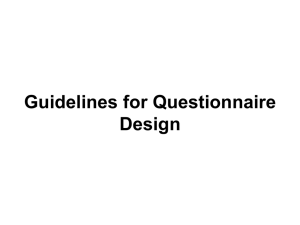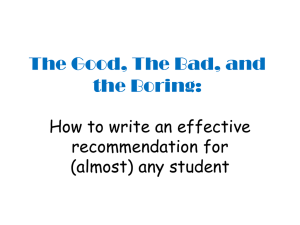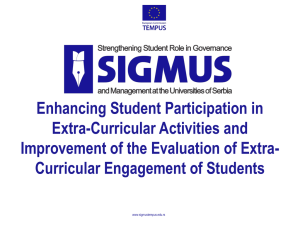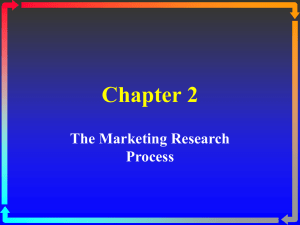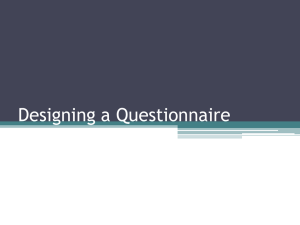Examining an innovative undergraduate dissertation approach: an
advertisement
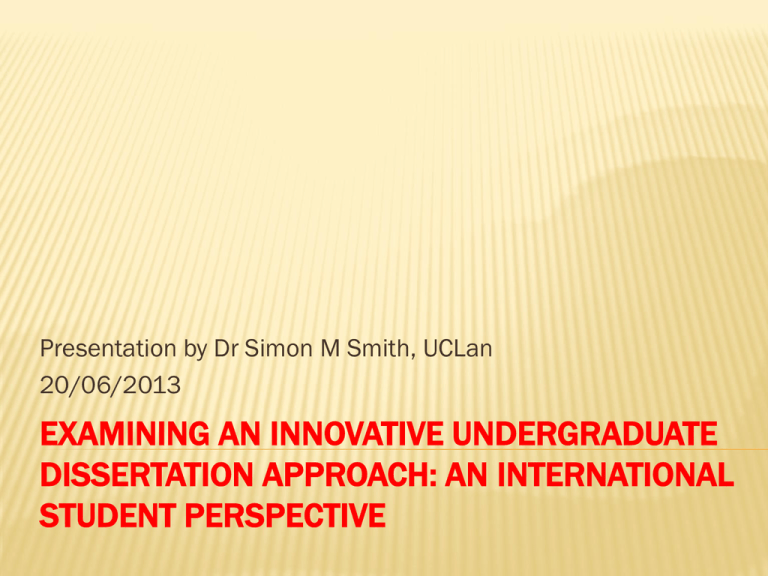
Presentation by Dr Simon M Smith, UCLan 20/06/2013 EXAMINING AN INNOVATIVE UNDERGRADUATE DISSERTATION APPROACH: AN INTERNATIONAL STUDENT PERSPECTIVE INTRODUCTION Initial data analysis regarding a project on undergraduate dissertations Longitudinal study over 1 year (for final year students) – 5 temporal points Researches a unique approach towards writing a dissertation 100% international students LITERATURE BACKGROUND [1] Under-researched area of study (Greenbank et al., 2008; Heinze and Heinze, 2009) “we believe that the dissertation … remains valid, relevant and purposeful” (Derounian, 2011) The issue of managing larger cohorts (Day and Bobeva, 2007) has led to innovative approaches (Akister et al., 2009) LITERATURE BACKGROUND [2] 3 examples of competency values that can impact on autonomous learning (Greenbank and Penketh, 2009): Previous experiences of writing Level of confidence in their ability to write Nature of their relationship from those they seek advice from Definitely worth exploring these issues with international students (i.e. second language learners) A UNIQUE APPROACH 4 stages of 6000 word dissertation: Proposal: formative feedback Literature review (2000 words): January deadline Data analysis and discussion (2000 words): March deadline Final dissertation (whereby introduction, research methods and conclusions are primarily marked) At five temporal points, data were collected SAMPLE DETAILS 310 dissertation students (total of 546 responses) Questionnaire 1: 144 responses (46.5%) Questionnaire 2: 104 responses (33.5%) Questionnaire 3: 172 responses (55.5%) Questionnaire 4: 79 responses (25.5%) Questionnaire 5: 47 responses (15%) Data were fed into SPSS Participant Frequency Over Time 180 160 140 120 100 80 60 40 20 0 Questionnaire 1 Questionnaire 2 Questionnaire 3 Questionnaire 4 Questionnaire 5 Participant Frequency By Nationality 300 250 200 150 100 50 0 Chinese German French Spanish Questions Questionnaire Question codes Out of 1 2 3 4 5 4 Course happiness 5 3.78 (0.77) 3.74 (0.80) 3.48 (0.66) 3.87 (0.68) 3.80 (0.86) 5 Transition 5 2.29 (0.85) 2.16 (0.870) 2.18 (0.84) 1.93 (0.60) NA 6 Module happiness 5 3.80 (0.73) 3.55 (0.74) 3.21 (0.85) 3.69 (0.872) NA 7 Ass’t anxiety 4 2.36 (0.77) 2.36 (0.75) 2.34 (0.65) NA NA 8 Challenge 5 3.12 (0.79) 2.92 (0.68) 2.82 (0.87) 2.59 (0.82) NA 9 Mark/ feedback 5 NA NA 3.06 (0.99) 3.73 (0.91) 3.59 (0.95) 10 Feedback/ usefulness 5 NA NA 3.41 (0.89) 3.63 (0.85) NA 11 Support 5 NA NA 3.53 (0.88) 3.65 (0.94) NA 12 Next ass’t anxiety 4 2.22 (0.73) 2.31 (0.73) 2.42 (0.72) 2.30 (0.78) NA 13 Confidence 4 2.56 (0.72) 2.57 (0.71) 2.40 (0.69) 2.94 (0.84) NA 14 Content relevance 4 1.87 (0.56) 2.00 (0.63) 2.15 (0.58) 1.94 (0.61) NA 15 Lang’ Understanding 5 2.28 (0.93) 2.07 (0.87) 2.20 (0.88) 1.92 (0.84) NA 16 Teaching style 4 2.46 (0.81) NA NA NA NA INITIAL THOUGHTS ON THE DATA ANALYSIS Student perceptions of marks changed for different assessments: Literature review mark: Negative = 27.4% versus Positive = 32% Data analysis and discussion mark: Negative = 8.9% versus Positive = 58.2% Final dissertation mark: Negative = 12.7% versus Positive = 59.6% Interestingly, the negative responses for feedback on the assessment and support from the tutor do not coincide with these – they are generally more positive INITIAL THOUGHTS ON THE DATA ANALYSIS Happiness on the course remained fairly consistent throughout the study However, happiness with the dissertation module changed significantly in questionnaire 3 Here are the accumulative questionnaire responses that were negative (questionnaire 1-4): 2.1% to 6.7% to 17.5% to 9.1% Coincides with the first summative mark given to the students for the literature review It is clear that, for some students, there were some real issues on this module INITIAL THOUGHTS ON THE DATA ANALYSIS Chinese students struggled much more with transition into UK life, as well as with understanding the language in class – these issues remained persistent throughout the year; it only reduced slightly over time Spanish and French students are a distant second and third respectively German, Italian, Turkish, and Vietnamese students have found transition comfortable or simple DEFINITE PATTERNS FOR EXTENDED ANALYSIS Marks, feedback and support Nationality, transition and understanding of the language Course happiness and module happiness Anxiety of assessments and challenge of assessments Relevance of classroom input and support from the tutor WHERE NEXT? Finishing the data analysis using SPSS Draw together overarching findings and conclusions Collecting further qualitative data – contacting former students and possibly staff (if time permits) Produce a REFable paper



